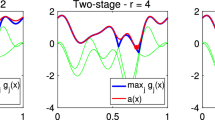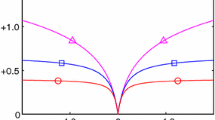Abstract
One class of min-sum-min problems is discussed in the paper. Min-sum-min problems appear in a natural way in many applications (e.g., in cluster analysis, pattern recognition, classification theory etc.). Like min-max-min problems, min-sum-min problems represent a very important family of nonsmooth problems. Problems of this type can be treated by means of the existing tools of Nonsmooth Analysis. However, most of algorithms available provide a local minimizer only, since they are based on necessary conditions which are of local nature. In the paper it is proved that the original problem can be reduced to the problem of minimizing a finite number of sum-functions. A necessary condition for a global minimum and a sufficient condition for a local minimum are stated. The necessary condition is of nonlocal nature. An algorithm (so-called Exchange algorithm) for finding points, satisfying necessary conditions, is described. An ɛ-Exchange algorithm is formulated, allowing, in principle, to escape from a ‘shallow’ local minimizer. An example is presented to illustrate the results and algorithms. An application of the proposed algorithms to solving one clustering problem is also given. Numerical results are provided.
Similar content being viewed by others
References
A. Astorino M. Gaudioso (2002) ArticleTitlePolyhedral separability through successive LP Journal of Optimization Theory and Applications 112 IssueID2 265–293 Occurrence Handle10.1023/A:1013649822153
A.M. Bagirov A.M. Rubinov A. Stranieri J. Yearwood (1999) The global optimization approach to the clustering analysis Research Report 45/99 University of Ballarat Australia
A.M. Bagirov A.M. Rubinov J. Yearwood (2002) ArticleTitleA global optimization approach to the classification Optimization and Engineering 3 129–155 Occurrence Handle10.1023/A:1020911318981
A.M. Bagirov A.M. Rubinov J. Yearwood (2001) ArticleTitleUsing global optimization to improve classification for medical diagnosis Topics in Health Information Management 22 65–74
A.V. Demyanov (2003) An exchange algorithm forminimizing sum-min functions L. Qi K.L. Teo X.Q. Yang (Eds) Optimization and Control with Applications Kluwer Academic Publisher Nowell MA USA 213–234
Demyanov A.V. (2002) On the solution of minmaxmin problems. Vestnik of Saint-Petersburg University Ser 1 Issue 3 (No. 17) 3–9
A.V. Demyanov V.F. Demyanov V.N. Malozemov (2002) ArticleTitleMinmaxmin problems revisited Optimization Methods and Software 17 IssueID5 783–784 Occurrence Handle10.1080/1055678021000060810
O.L. Mangasarian (1997) ArticleTitleMathematical programming in data mining. Data Mining and Knowledge Discovery 1 183–201 Occurrence Handle10.1023/A:1009735908398
Pardalos P. and Resende M. (eds.) (2002) Handbook of Applied Optimization. Oxford University Press
A.M. Vershik V.N. Malozemov A.B. Pevnyi (1975) ArticleTitleThe best piecewise polynomial approximation. Siberian Mathematical Journal XVI 5 925–938
Author information
Authors and Affiliations
Corresponding author
Additional information
AMS Subject Classification:90C30, 49J40.
Rights and permissions
About this article
Cite this article
Demyanov, A. On the Solution of Min-sum-min Problems. J Glob Optim 31, 437–453 (2005). https://doi.org/10.1007/s10898-004-7018-4
Received:
Revised:
Accepted:
Issue Date:
DOI: https://doi.org/10.1007/s10898-004-7018-4




